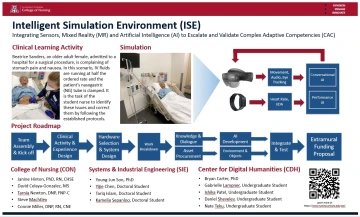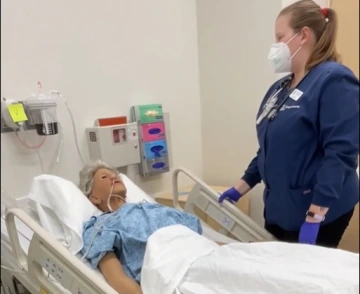UArizona Nursing SensorLab Seed Grant Funds Research into Artificial Intelligence Student Assessments

In January 2022, Janine Hinton, PhD, MN, RN, CHSE, University of Arizona College of Nursing Director, Steele Innovative Learning Center, received a SensorLab Seed Grant to conduct an exploratory study of the capabilities of sensor technology. The technology will be deployed as a virtual reality patient assessment training ground for nursing students.
“Essentially, we want the prototype we’re building to be able to immerse students in a realistic environment where they can practice solving problems and the environment can also assess and provide feedback,” Dr. Hinton says. “We’re hoping that in some ways the system will be more objective, and that it will provide an efficient and eventually cost-effective way for students to learn in a formative assessment type approach and for summative assessment.”
“Essentially, we want the prototype we’re building to be able to immerse students in a realistic environment where they can practice solving problems and the environment can also assess and provide feedback," ~ Janine Hinton, PhD, MN, RN, CHSE

“They’re making great progress with creating this system,” Dr. Hinton says. “When this all gets woven together, we’ll have the foundation to be able to continue building on that work and also going after larger funding opportunities.”
The ISE prototype will ultimately be able to immerse students in a realistic environment where they can practice solving problems and receive assessments and feedback about their performance. “We don’t have a mind-reading system, so this is the closest we can get,” Dr. Hinton says, noting that many years of research lie ahead for the program.
After the initial building blocks have been laid, student responses will be compared to the results of experts solving particular problems using the Artificial Intelligence (AI) resources. “AI resources learn how they do it and then you can take someone who is a novice or an advanced beginner and have them try to solve the same problem,” Dr. Hinton says. “The AI agent should be able to find the difference and also provide some hints and clues to help the performance of the novice.”

In the end, Dr. Hinton aims to integrate the program into everyday student training, which will also be a boon to the faculty who typically take part in the student assessments. “We’re hoping that in some ways the system will be more objective, and that it will provide an efficient and eventually cost-effective way for students to learn in a formative assessment type approach and for summative assessment,” Dr. Hinton says. Currently, assessing nurse performance during a training can take up to 10 experts who review the recorded simulation test and render a fair judgement of the student’s performance. It’s an expensive approach that requires extensive training and stamina. “AI doesn’t get tired, it just needs electricity,” Dr. Hinton says. “If it’s set up well, then we can utilize the expertise of those faculty members for training and addressing things that the AI and the virtual coach can’t.”
Dr. Hinton hopes the Intelligence Simulation Environment prototype will go on to have an even greater impact of patient care than helping train students hone their problem-solving skills. “We have lots of problems in health care,” she points out. “It’s complex, it’s so challenging, and what we know about it changes. We have so many mistakes and we’re expecting people to just be amazing and brilliant out of the gates long term and just be able to solve these problems.”
Currently, medical errors are the third leading cause of death in healthcare settings. With enough time and effort, the ISE may be able to put a dent in that troubling statistic. “If it works really well and there’s a way to transfer it to actual practice then maybe the nurses and healthcare providers of the future will be wearing little headsets or eyeglasses and they’ll take their little AI buddy with them,” Dr. Hinton says.
The Intelligent Simulation Project was made possible in part through funding from CUES, the Center for University Education Scholarship at the University of Arizona. Any views, findings, or recommendations hereby expressed are those of the author(s) only.

